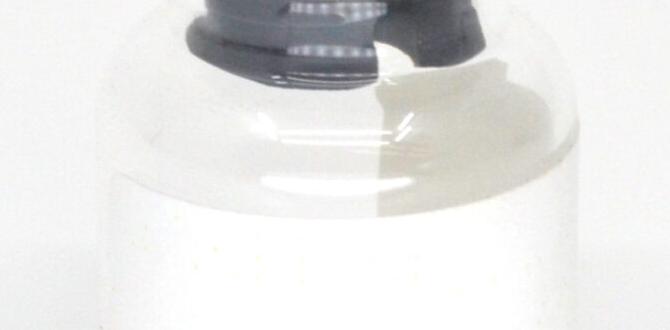Clean your nail gun filters often to keep your tool working smoothly and prevent costly repairs. Replacing or thoroughly cleaning filters ensures consistent power and air quality, extending your nailer’s lifespan and improving project results. It’s a simple, essential maintenance step every DIYer should master for reliable performance.
Hey there, fellow woodworkers and DIY enthusiasts! Jack Shaffer, your Nailerguy, here. Ever notice your trusty nail gun sputtering, losing power, or just not driving nails with the same confidence it used to? It can be super frustrating, especially when you’re in the middle of a project and things aren’t going as planned. Often, the culprit isn’t a major mechanical failure, but something much simpler: a clogged nail gun filter.
Think of your nail gun’s filter like the air filter in your car. It keeps dust, debris, and moisture out of the delicate internal mechanisms. When that filter gets clogged, the air supply gets restricted, just like when your car’s air filter is dirty. This directly impacts the tool’s performance – reduced power, inconsistent firing, and premature wear and tear.
The good news is that cleaning or replacing these filters is usually a straightforward process. It’s a vital part of regular tool maintenance that many beginners overlook. But don’t worry, we’re going to walk through it step-by-step. You’ll be back to driving nails like a pro in no time, all while keeping your tool in top shape for years to come. Ready to give your nailer the attention it deserves?
This guide will show you exactly why keeping those filters clean is so important, what tools you’ll need, and the simple, repeatable steps to get it done. We’ll cover different types of filters and even when it’s time for a replacement. Let’s dive in and make sure your nail gun is always ready for action!
Table of Contents
Why Cleaning Nail Gun Filters Regularly is Essential
It might seem like a small detail, but the air filter on your nail gun plays a crucial role in its overall health and performance. Neglecting it is like trying to breathe through a stuffy nose – everything becomes a struggle!
When you use a nail gun, it draws in air from its surroundings. This air isn’t always perfectly clean. It can carry fine dust particles, sawdust, insulation fibers, and even tiny bits of metal from everyday use. If this dirty air is sucked directly into the nailer’s pneumatic system, it can cause a cascade of problems.
Here’s a breakdown of why keeping those filters pristine is a game-changer:
- Consistent Power and Performance: A clean filter ensures unrestricted airflow. This means your nail gun receives the optimal amount of compressed air needed to drive nails with full force and consistently. A dirty filter restricts this flow, leading to weaker shots, partially driven nails, and frustration.
- Prevents Internal Damage: The tiny particles we talked about can enter the piston, cylinder, and other moving parts. Over time, this can act like sandpaper, causing excessive wear, scoring cylinder walls, and damaging seals. This leads to leaks, reduced efficiency, and expensive repairs.
- Extends Tool Lifespan: Regular cleaning and maintenance, including filter care, are the cornerstones of making your tools last. By preventing wear and tear caused by debris, you’re essentially giving your nail gun a longer, more productive life.
- Improves Air Quality for Pneumatic Tools: If you use multiple pneumatic tools on one compressor, a clean filter at each tool (or a good quality compressor filter) helps ensure that clean air is distributed throughout your system. This benefits all your air-powered equipment.
- Reduces Moisture Buildup: Filters can also help trap some moisture from the air, especially if you don’t have a dedicated air dryer. Moisture in a pneumatic system can lead to rust and corrosion inside the tool and on fasteners, causing them to jam or fail.
- Saves Money in the Long Run: While buying a new filter or cleaning supplies is a small investment, it’s far cheaper than repairing or replacing a damaged nail gun. Preventing these issues is key to cost-effective tool ownership.
Think of it as preventative medicine for your tools. A little bit of regular attention can save you a whole lot of heartache and money down the road. Let’s get into how to do it.
Understanding Nail Gun Filters
Before we start cleaning, it’s helpful to know what we’re dealing with. Nail gun filters aren’t all the same, but they generally serve the same purpose: to protect the tool from airborne contaminants.
Most commonly, you’ll encounter one of two types of filters:
Inline Air Filters
These are typically small, translucent plastic or metal cylinders that connect between your air hose and the nail gun’s air inlet. They are designed to catch debris and moisture before the air even enters the tool.
- Features: Often have a clear bowl so you can see the collected contaminants. Many also have a small release valve at the bottom to drain accumulated water.
- Location: Fitted directly at the nail gun’s air port or at the end of the air hose.
- Maintenance: Usually involves unscrewing the bowl, emptying debris and water, rinsing the filter element inside (if washable), and reassembling. Some have replaceable cartridges.
Internal Intake Filters
These filters are situated inside the nail gun itself, usually at the air inlet nipple where you attach the air hose. They are often made of a fine mesh or fibrous material.
- Features: Small, often cylindrical or disc-shaped, made of mesh, felt, or foam.
- Location: Tucked into the air inlet port of the nail gun. You might need to remove the air hose collar or a small cap to access it.
- Maintenance: Involves carefully removing the filter, cleaning it (often by blowing compressed air through it backwards or washing it), drying it thoroughly, and reinstalling it. Some may be disposable and require replacement.
Some high-quality compressors also have built-in filtration systems. While these are excellent for overall air quality, they don’t replace the need for a filter directly at the nail gun, especially for intricate tools or when working in particularly dusty environments. For DIYers, focusing on the inline or internal filters is usually the most direct path to maintaining your nail gun’s performance.
Tools and Materials You’ll Need
Fortunately, cleaning nail gun filters is not a high-tech operation. You likely already have most of what you need in your workshop or garage. Gathering these items beforehand makes the process smooth and efficient.
Here’s a checklist:
- Safety Glasses: Absolutely essential to protect your eyes from any dust, debris, or cleaning solutions that might become airborne.
- Gloves (Optional but Recommended): Protect your hands, especially if you’re using cleaning solutions or dealing with greasy residue.
- Compressed Air Source: This is your best friend for cleaning. An air compressor with a blow gun attachment is ideal. If you don’t have a compressor, you can sometimes use canned air, but it’s less effective and more expensive for regular cleaning. A quality compressor is a great investment for any DIYer; check out resources like Popular Mechanics’ guide to the best air compressors for some ideas.
- Soft Brush: A small toothbrush or a soft detailing brush can help dislodge stubborn dust from filter elements.
- Mild Soap and Water (for washable filters): Many washable filter elements can be cleaned gently with mild dish soap and warm water.
- Clean Cloths or Rags: For wiping down parts and ensuring everything is dry.
- Small Screwdriver or Pliers (Occasionally): Some filter housings might have small screws or require pliers for gentle leverage.
- Replacement Filter (if needed): Keep this on hand, especially for disposable filters or if yours is damaged beyond cleaning.
- Owner’s Manual: Always a good idea to consult your specific nail gun’s manual. It will detail the exact filter type, its location, and recommended cleaning procedures.
Having these items ready will ensure you can tackle the filter cleaning without any interruptions. It’s a quick process, and being prepared makes it even faster!
Step-by-Step Guide: How to Clean Nail Gun Filters Regularly
Alright, let’s get down to business! Cleaning your nail gun’s filter is a straightforward process, and we’ll break it down into easy-to-follow steps. We’ll cover both inline and internal filter types.
Step 1: Safety First! Disconnect the Air Supply
This is the most critical step. Before you do anything else, disconnect the air hose from your nail gun. Ensure the air pressure is released from the tool. Think of it like unhooking the power cord before repairing an appliance – it’s non-negotiable for your safety.
If your nail gun has an air pressure adjustment knob, you might want to turn it down or off completely before disconnecting. This prevents any accidental bursts of air when you start working on the tool.
Step 2: Locate Your Nail Gun’s Filter
This will depend on the type of filter your nail gun uses:
- For Inline Filters: Look for a component attached between the air hose and the nail gun’s air inlet. It’s usually a small, often clear, cylinder.
- For Internal Filters: The filter is located inside the nail gun’s air inlet port. You might be able to see it when the air hose is detached. Sometimes, you need to slide off a collar or unscrew a small cap to expose it.
Consult your nail gun’s owner’s manual if you’re unsure. It will have diagrams and specific instructions for your model.
Step 3: Disassemble and Inspect the Filter
For Inline Filters:
- Most inline filters have a plastic bowl that unscrews from the main housing. Gently twist the bowl counter-clockwise. Be careful, as some might be snug.
- Once the bowl is off, you’ll see the filter element inside. Carefully remove it.
- Inspect the bowl for accumulated water and debris.
- Inspect the filter element for dust, dirt, or any damage.
For Internal Filters:
- If the filter is visible at the inlet, you might be able to gently pull it out with your fingers or needle-nose pliers.
- If it’s recessed, you might need to remove a small cap or collar around the air inlet. Check your manual for specific instructions on how to access and remove the internal filter.
- Carefully remove the filter element. Note its orientation so you can reinstall it correctly.
- Check the air inlet port for any debris that might have bypassed the filter.
Step 4: Clean the Filter Element
The cleaning method depends on the filter material:
For Washable Elements (Mesh, Foam, or some Fibrous types):
- Gently rinse the filter under warm running water.
- If there’s stubborn dust, use a soft brush (like a toothbrush) and a tiny bit of mild dish soap. Scrub gently.
- Rinse thoroughly to remove all soap residue.
- Crucially: Dry the filter COMPLETELY. You can shake off excess water and let it air dry completely on a clean rag. Using a damp filter can lead to moisture issues inside the nail gun. Alternatively, a very light blast of compressed air can help speed up drying, but be careful not to damage delicate materials.
For Internal Filters (often very fine mesh or fibrous):
- The best method is often to blow compressed air through the filter from the opposite direction of normal airflow. This pushes the debris out rather than further in. Hold the filter a safe distance away from the nozzle to avoid damage.
- If compressed air doesn’t do the trick, you might need to rinse it, but ensure it dries 100% before reinstallation. Some very fine filters are disposable and best replaced regularly.
Step 5: Clean the Filter Housing (Inline Filters)
While the filter element is drying or if you’re not washing it, take this time to clean the filter bowl and housing from your inline filter.
- Empty any collected water and debris from the bowl.
- Wipe out the inside of the bowl and housing with a clean, dry cloth.
- If there’s significant moisture or residue, you can wipe it with a cloth lightly dampened with isopropyl alcohol. Ensure alcohol evaporates completely before reassembly.
Step 6: Reassemble the Filter and Tool
Once all parts are clean and completely dry:
- For Inline Filters: Carefully place the clean, dry filter element back into its housing. Screw the bowl back onto the housing, ensuring a snug but not overtightened fit.
- For Internal Filters: Gently place the clean, dry filter back into the air inlet port of the nail gun, making sure it’s seated correctly. Reattach any caps or collars you removed.
Important Note: If any part of your filter is torn, damaged, or clogged beyond cleaning, it’s time for a replacement. Don’t try to force a damaged filter to work; it defeats the purpose and can harm your tool.
Step 7: Reconnect and Test
Reconnect the air hose to the nail gun’s air inlet. Turn on your air compressor and allow the air pressure to build. Give a few test fires to ensure the nail gun is operating at full power and without any issues.
Congratulations! You’ve successfully cleaned your nail gun filter. This simple maintenance task ensures your tool runs efficiently and lasts longer.
Filter Cleaning Frequency: When and How Often?
Knowing how to clean the filters is one thing, but when to do it is just as important. The frequency of filter cleaning depends on several factors, including how often you use your nail gun, the environment you’re working in, and the type of filter you have.
Here’s a general guideline:
- Light Home Use (a few projects a year): Check your filters at least every six months. If you notice any dust accumulation or decreased performance, clean them sooner.
- Moderate DIY Use (monthly projects, weekend warrior): Inspect and clean your filters monthly. Pay close attention after dusty tasks like drywall or insulation work.
- Professional or Frequent Use (daily or weekly): These filters should be checked and cleaned weekly, if not more often. Some professionals even clean them at the end of each day, especially if working in very dusty conditions.
Environmental Factors:
- Dusty Environments: If you’re working with lumber that’s been sitting outside, in a dusty attic, or doing demolition work, your filters will clog much faster. Check them hourly or after significant dust exposure if performance dips.
- Moisture: If you live in a humid climate or work in damp conditions, pay extra attention to moisture buildup in inline filters. Drain them regularly.
- Clean Workshop: If you maintain a very clean workshop with dust extraction, your filters will naturally last longer between cleanings.
Filter Type Considerations:
- Washable Filters: These can be cleaned multiple times. However, over time, even washable filters can degrade, tear, or become permanently blocked. Inspect them for wear and tear.
- Disposable Filters: These are designed to be replaced. Follow the manufacturer’s recommendations for replacement intervals, or replace them immediately if they appear clogged or damaged.
Signs It’s Time to Clean (or Replace):
- Reduced nail driving power.
- Nails not fully sinking into the material.
- The nail gun feels sluggish or “weak.”
- Visible dust or debris on the outside of the filter or inside the filter housing.
- For inline filters, a significant amount of water or debris in the collection bowl.
Think of it as listening to your tool. If it’s not performing right, a dirty filter is often the first and easiest thing to check and fix. A routine of inspection and cleaning, tailored to your usage, will keep your nail gun humming.
When to Replace Your Nail Gun Filters
While regular cleaning keeps filters in good shape, they aren’t immortal. Eventually, they need to be replaced. Knowing when that time comes is as important as the cleaning itself.
Factors indicating it’s time for a new filter include:
- Visible Damage: If the filter material is torn, ripped, or has holes, it’s no longer effectively filtering the air. It needs replacement immediately.
- Permanent Clogging: Some fine dust or residue can become deeply embedded in filter material, making it impossible to clean thoroughly. If blowing air through it or washing it doesn’



